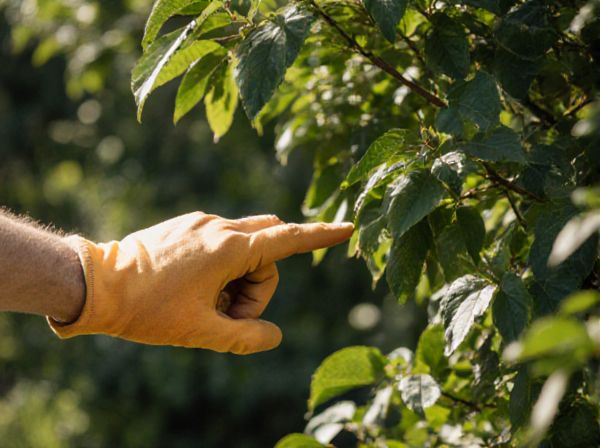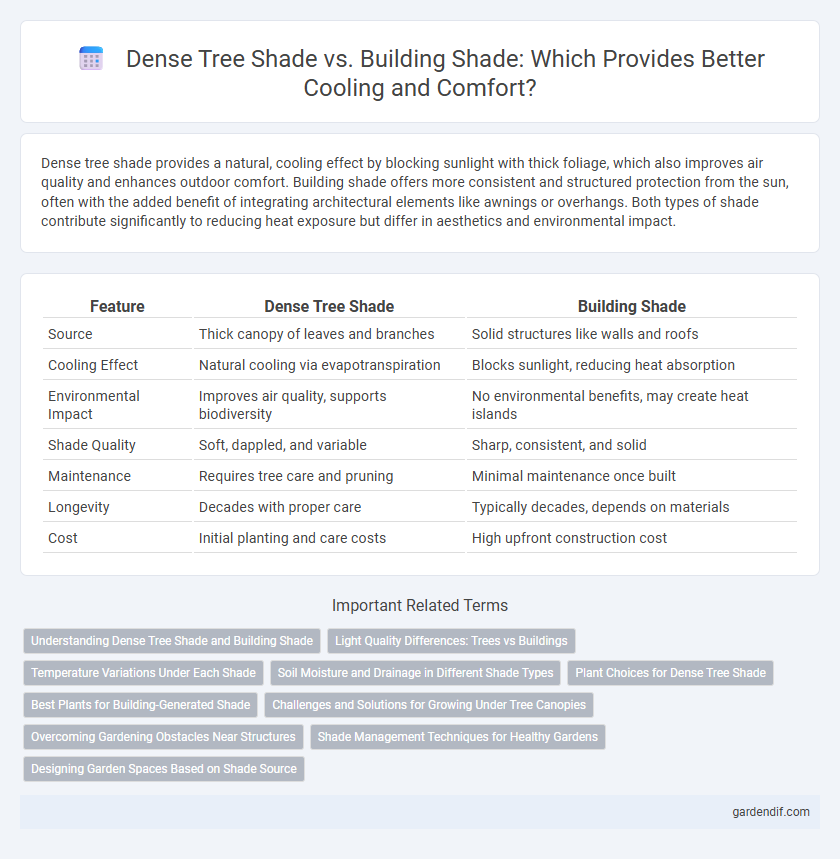
Dense Tree Shade vs Building Shade Illustration
Dense tree shade provides a natural, cooling effect by blocking sunlight with thick foliage, which also improves air quality and enhances outdoor comfort. Building shade offers more consistent and structured protection from the sun, often with the added benefit of integrating architectural elements like awnings or overhangs. Both types of shade contribute significantly to reducing heat exposure but differ in aesthetics and environmental impact.
Table of Comparison
| Feature | Dense Tree Shade | Building Shade |
|---|---|---|
| Source | Thick canopy of leaves and branches | Solid structures like walls and roofs |
| Cooling Effect | Natural cooling via evapotranspiration | Blocks sunlight, reducing heat absorption |
| Environmental Impact | Improves air quality, supports biodiversity | No environmental benefits, may create heat islands |
| Shade Quality | Soft, dappled, and variable | Sharp, consistent, and solid |
| Maintenance | Requires tree care and pruning | Minimal maintenance once built |
| Longevity | Decades with proper care | Typically decades, depends on materials |
| Cost | Initial planting and care costs | High upfront construction cost |
Understanding Dense Tree Shade and Building Shade
Dense tree shade provides natural cooling by blocking sunlight with thick foliage, significantly reducing ground temperature and enhancing air quality through photosynthesis. Building shade, created by architectural structures, offers consistent protection from direct sunlight but lacks the environmental benefits such as carbon absorption and oxygen release provided by trees. Understanding the differences between dense tree shade and building shade highlights the ecological advantages of vegetation in urban cooling strategies.
Light Quality Differences: Trees vs Buildings
Dense tree shade filters sunlight through leaves, producing a dappled, softer light with varying intensity and color temperature due to natural foliage transmission. Building shade creates a more uniform and solid shadow with minimal light diffusion, resulting in consistent and cooler light conditions. The interplay of shadows and light quality under trees often supports greater biodiversity compared to the harsher, more static shade cast by buildings.
Temperature Variations Under Each Shade
Dense tree shade can reduce surface temperatures by up to 10degF compared to areas exposed to direct sunlight, providing a significant cooling effect through evapotranspiration and leaf canopy. Building shade typically lowers temperatures by about 5degF, primarily due to blocking solar radiation but often creating heat retention on adjacent walls or pavement. Temperature variations under tree shade are generally more stable and cooler throughout the day, while building shade experiences greater fluctuations depending on sun angle and material heat absorption.
Soil Moisture and Drainage in Different Shade Types
Dense tree shade significantly affects soil moisture retention by reducing evaporation rates, creating a cooler and more humid microenvironment that promotes better water availability for plants. In contrast, building shade often results in poor drainage due to impervious surfaces like concrete, limiting soil infiltration and increasing runoff. Understanding these differences is crucial for landscape management and irrigation planning to optimize soil health and plant growth under varying shade conditions.
Plant Choices for Dense Tree Shade
Plants thriving in dense tree shade require high shade tolerance and low light dependency, favoring species such as ferns, hostas, and astilbes that adapt well to limited sunlight and compete effectively for nutrients. Under dense canopy cover, shallow-rooted plants like bleeders and deciduous groundcovers perform better than deep-rooted species, ensuring optimal moisture absorption and growth. Selecting native shade-tolerant shrubs and perennials enhances biodiversity and sustainability in garden ecosystems dominated by dense tree shade.
Best Plants for Building-Generated Shade
Building-generated shade creates cooler microclimates ideal for shade-tolerant plants such as hostas, ferns, and astilbes. These plants thrive in low-light conditions common near building walls, benefiting from reduced sun exposure and consistent moisture retention. Selecting native shade-loving species enhances biodiversity and supports local ecosystems around shaded architectural structures.
Challenges and Solutions for Growing Under Tree Canopies
Dense tree shade creates low light conditions that limit photosynthesis, resulting in stunted growth and poor plant health under tree canopies. Building shade often produces more uniform but less intense shade, creating different microclimates that can be easier to manage for understory plant growth. Solutions for thriving under dense tree shade include selecting shade-tolerant species, optimizing soil fertility, and pruning tree canopies to increase light penetration while managing root competition.
Overcoming Gardening Obstacles Near Structures
Dense tree shade creates a unique microclimate with filtered light, ideal for shade-tolerant plants that thrive in dappled sunlight, while building shade often results in cooler, more consistent shading conditions with limited airflow. Overcoming gardening obstacles near structures requires selecting resilient plant species adapted to reduced light and moisture retention challenges, such as ferns, hostas, and certain groundcovers. Strategic placement of reflective surfaces and soil amendments helps optimize growth by improving light exposure and nutrient availability in these shaded environments.
Shade Management Techniques for Healthy Gardens
Dense tree shade provides natural cooling and reduces soil moisture loss, creating an ideal microclimate for shade-tolerant plants, while building shade primarily blocks direct sunlight but may alter airflow and humidity differently. Effective shade management techniques include strategic pruning to control canopy density in trees and installing reflective surfaces near buildings to optimize light distribution. Combining these methods helps maintain soil health, prevents fungal growth, and promotes balanced plant development in gardens affected by various shade sources.
Designing Garden Spaces Based on Shade Source
Designing garden spaces requires understanding the differences between dense tree shade and building shade, as tree shade tends to be dappled and variable, promoting a diverse understory of shade-tolerant plants. Building shade is more consistent and often colder, making it suitable for shade-loving ground covers and hardy shrubs that can tolerate less sunlight and cooler microclimates. Selecting plants based on the source and quality of shade enhances garden health and aesthetic appeal by optimizing growth conditions.
Dense Tree Shade vs Building Shade Infographic

 gardendif.com
gardendif.com